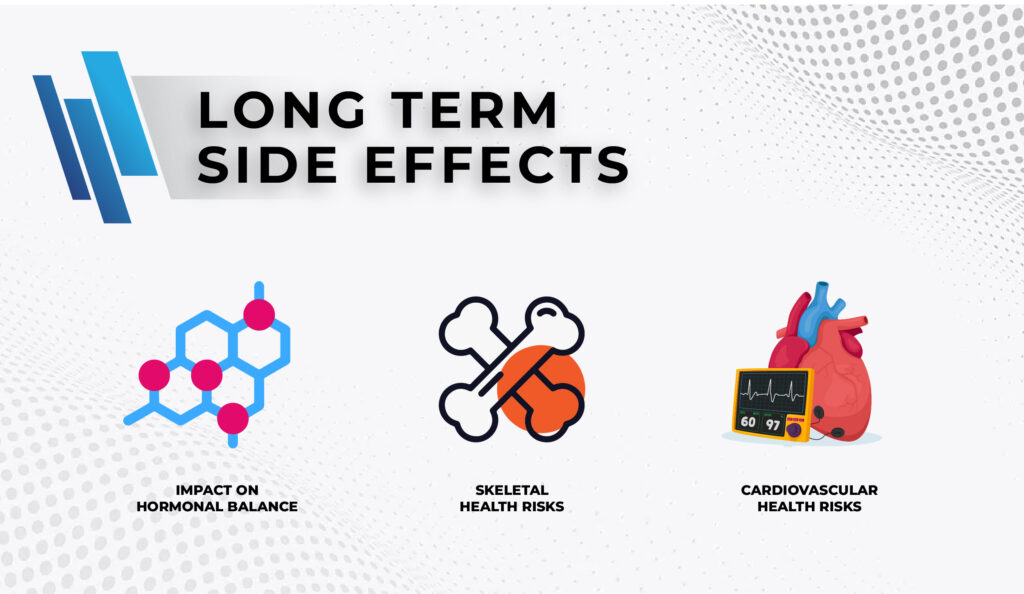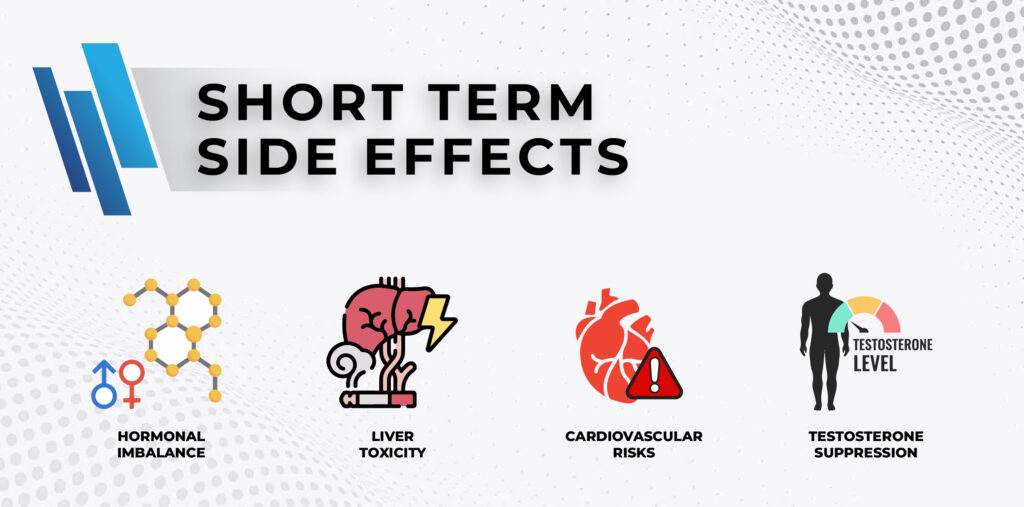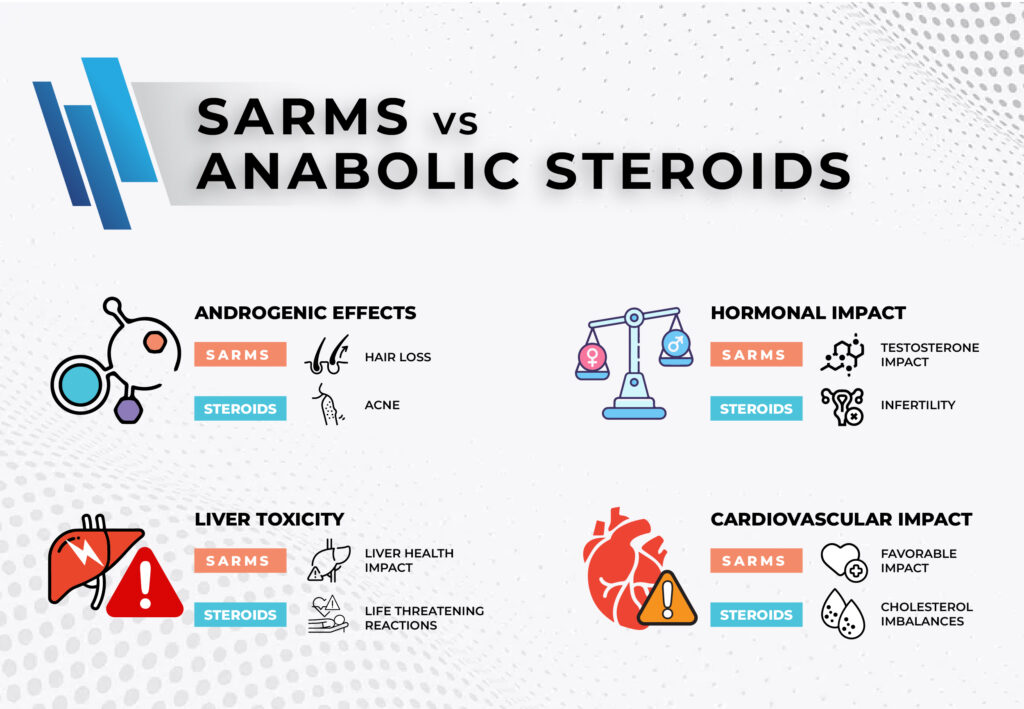Muscle Insider
New member

In the pursuit of achieving optimal fitness and muscle gains, many individuals turn to Selective Androgen Receptor Modulators (SARMs) as an alternative to traditional steroids.
While SARMs promise targeted results with fewer side effects, the long-term implications of their usage remain a subject of concern.
This article delves into the intricacies of SARMs and explores the potential long-term side effects that users may encounter.
From hormonal imbalances to cardiovascular risks, understanding the nuanced impact of SARMs on the body is crucial for individuals navigating the complex landscape of performance-enhancing substances.
Unveiling the lesser-known consequences, this exploration of the long term side effects of SARMS aims to shed light on the importance of informed decision-making in the pursuit of fitness goals.
Understanding SARMS (Selective Androgen Receptor Modulators)
Selective Androgen Receptor Modulators (SARMs) are a class of compounds designed to mimic the effects of anabolic steroids while minimizing the associated side effects.
SARMs, short for Selective Androgen Receptor Modulators, are synthetic drugs with properties similar to anabolic steroids.
Unlike steroids that impact the entire body, SARMs selectively target androgen receptors in specific tissues, such as muscles and bones.
SARMs aim to enhance muscle growth by binding to androgen receptors, promoting protein synthesis, and increasing nitrogen retention.
One key feature is their purported selectivity, theoretically minimizing unwanted side effects common in traditional steroids.
SARMs have shown promise in medical fields, including potential treatments for muscle wasting conditions, osteoporosis, and hypogonadism.
Many individuals in the fitness community turn to SARMs to improve performance, accelerate muscle gains, and reduce the risk of side effects associated with traditional steroids.
SARMs are not approved by the FDA for medical use, and their sale is often illegal or unregulated, raising concerns about product quality and safety.
These cannot be marketed as dietary supplements. You will also run into issues when conversing with the World Anti-Doping Agency, seeing as SARMs are a banned substance
Understanding the intricacies of SARMs is essential for those considering their use, as potential long-term consequences may outweigh the short-term benefits.
As the regulatory landscape evolves, informed decision-making becomes increasingly crucial in the realm of fitness and performance enhancement.
Long Term Side Effects of SARMS

The big question remains – what are the long term effects of SARMs? SARMs are relatively new compared to other compounds on the market, such as Steroids.
See, steroids have been studied since the early 1900s, and while their effects on muscle mass are unrivaled, we also know they have a tremendous number of sides – liver damage, testosterone suppression, prostate cancer, etc.
SARMs have only been around for a couple of decades, a fraction of the time of steroids. Thus, there are some things you need to think about.
The FDA warns these compounds are not fully tested, and the ones that are show adverse effects.
These unapproved substances might have a tremendous number of side effects that we do not even know of yet!
However, the few available clinical studies have documented the following side effects.
The Potential Impact on Hormonal Balance
One of the central findings of relevant studies is the notable suppression of testosterone levels associated with SARMs.
This discovery is of paramount importance, given that testosterone plays a vital role in various physiological functions, including muscle development, energy levels, and overall male reproductive health.
Understanding these specific pathways and interactions is crucial for comprehending the physiological changes brought about by SARM usage.
Importantly, this study [1] highlights the potential clinical implications of hormonal suppression induced by SARMs, especially in individuals with obesity.
Such alterations in hormone levels can have wide-ranging effects on metabolic health and overall well-being.
For individuals considering or currently using SARMs, the study underscores the significance of comprehending their impact on testosterone levels.
This hormonal alteration may have far-reaching consequences on physical and reproductive health, necessitating careful consideration and monitoring.
It will depend on SARM to SARM. One SARM might not react the same as other SARMs – just like they have potential benefits, they have potential sides, but not all of them will always be present.
That said, this is one of the most common side effects, and will certainly influence your health in the long term as well as in the short term. Consumers need to pay close attention to this detail.
Skeletal and Cardiovascular Health Risks
The cardiovascular risks associated with Selective Androgen Receptor Modulators represent a critical concern.
Studies suggest that SARM usage may adversely impact cardiovascular health, potentially leading to elevated risks of heart-related issues.
These risks encompass alterations in lipid profiles, such as unfavorable changes in cholesterol levels, which are linked to an increased likelihood of atherosclerosis and cardiovascular events.
Additionally, SARMs may exert direct effects on blood vessels and heart function, posing potential threats to the cardiovascular system.
The precise mechanisms behind these risks require further exploration.
As individuals pursue the benefits of SARMs for muscle growth, understanding and mitigating the potential cardiovascular consequences become imperative for informed and responsible usage.
Exploring the Unknowns
The main concern with the ‘unknowns‘ is probably the adverse side effects related to cancer.
Several studies and reviews have explored the effects of SARMs on various aspects of health, including their impact on cancer risk.
Some research has suggested that SARMs might influence cell proliferation, androgen receptor signaling, and other pathways that could theoretically contribute to the development or progression of certain types of cancer.
However, the available evidence may be limited and not conclusive.
Short-Term Side Effects of SARMs

The short-term side effects are very apparent. We know these because we see them daily, in the lab and the gym.
SARMs might not be anabolic steroids, but their side effect profile is eerily similar.
SARMs were developed to replace Steroids in the medical field, for use in those suffering from medical conditions that relate to muscle loss.
This is why companies like Ligand Pharmaceuticals have gone out of their way to develop SARMs, to help the masses.
Medical experts believe SARMs and Peptides are the future.
Hormonal Imbalances:
- SARMs may disrupt the body’s natural hormonal balance, particularly affecting testosterone levels.
- Hormonal imbalances can lead to a range of issues, including reduced libido, mood swings, and potential long-term impacts on reproductive health.
Liver Toxicity:
- Some studies suggested a potential for liver toxicity with SARM use.
- Liver damage or dysfunction can have serious health consequences. Regular monitoring of liver function is advisable when using SARMs.
Cardiovascular Risks:
- SARMs may impact cardiovascular health by affecting lipid profiles and potentially contributing to atherosclerosis.
- Elevated risks of cardiovascular events and adverse changes in cholesterol levels may pose concerns for users.
Suppression of Natural Testosterone Production:
- SARMs can lead to a suppression of endogenous testosterone production.
- Reduced testosterone levels may hinder muscle recovery, energy levels, and overall well-being.
Post-cycle therapy may be necessary to restore natural testosterone production after SARM use.
Addressing the Misconception of SARMS as Harmless Supplements
Despite their allure for muscle-building benefits with purportedly fewer side effects than traditional steroids, SARMs carry inherent risks.
Scientific evidence suggests potential hormonal imbalances, liver toxicity, and cardiovascular complications associated with their use.
The misconception of SARMs as benign supplements stems from incomplete understanding and inadequate awareness of their potential health implications.
Acknowledging the intricacies of these compounds and dispelling the notion of harmlessness is crucial for users and fitness enthusiasts.
By fostering accurate information dissemination, we empower individuals to make informed choices, emphasizing the need for caution, responsible use, and ongoing research into the long-term effects of SARMs on overall health.
SARMS Mechanism of Action
How SARMS Interacts with Androgen Receptors
Structurally, SARMs are classified into steroidal and nonsteroidal categories, each influencing androgen receptor (AR) signaling uniquely.
Steroidal SARMs modify the testosterone molecule, impacting hydrophobicity and receptor interactions.
Nonsteroidal SARMs, emerging from various pharmaceutical companies, exhibit diverse structural classes, including aryl-propionamide, hydantoin, quinolinones, and others.
AR signaling pathologically allows androgen(SARM)/AR complexes to bind and enhance the expression of growth and proliferation genes that are normally not regulated by these complexes in either intermediate cells or luminal cells.
Comparison with Anabolic Steroids
Selective Androgen Receptor Modulators and steroids are both body-building products that interact with androgen receptors in the body, but they differ in their structure, mechanism of action, and potential side effects. Here are some key differences between SARMs and steroids:
SARMs









Benefits of SARMS
SARMs offer potential benefits, primarily in the realm of muscle and bone health.
It’s essential to note that research on SARMs is ongoing, and their long-term effects are not yet fully understood.
SARMs are designed to selectively target and activate androgen receptors in muscle tissue, promoting anabolic effects.
This can lead to increased muscle protein synthesis, potentially resulting in muscle growth and improved muscle strength.
Some SARMs have demonstrated an ability to enhance bone mineral density and improve bone health.
This makes them of interest for conditions like osteoporosis, where maintaining or increasing bone density is a primary goal.
One of the key advantages of SARMs is their tissue-selective action. They aim to target specific tissues, such as muscles and bones while minimizing effects on other organs.
This selectivity is intended to reduce the risk of unwanted side effects commonly associated with traditional steroids.
SARMs have been investigated for their potential to improve physical function, especially in populations facing functional limitations due to aging, chronic diseases, or other conditions.
This includes the potential to address muscle wasting and frailty.
Compared to traditional anabolic steroids, SARMs may have a milder impact on the endocrine system, specifically on natural testosterone production.
This can be advantageous for users aiming to minimize hormonal imbalances and potential side effects associated with significant alterations in hormone levels.
SARMS vs Anabolic Steroids: Health Implications

Both SARMs and Steroids are compounds listed as illegal by WADA, and for good reason.
Both of these can have severe sides, some of which are unknown or even lethal if pushed too far.
Warning consumers (SARM users) is thus vital, as these substances have strong side effects.
There are four main differences that we need to look at between SARMs vs Anabolic Steroids:
Androgenic Effects:
SARMs: Designed to be tissue-selective, with a focus on anabolic effects in muscle and bone while minimizing androgenic effects in other tissues.
This selectivity aims to reduce the risk of traditional androgenic side effects like acne, hair loss, and prostate enlargement.
Steroids: Can exert both anabolic and androgenic effects throughout the body, potentially leading to androgenic side effects in tissues such as the skin, hair, and prostate.
Hormonal Impact:
SARMs: Intended to have a milder impact on endogenous testosterone production, potentially minimizing hormonal imbalances.
However, the long-term effects on hormone levels are still under investigation.
Steroids: Often associated with significant suppression of natural testosterone production.
Prolonged steroid use can lead to hormonal imbalances, which may result in issues such as testicular atrophy, infertility, and mood swings.
Liver Toxicity:
SARMs: Generally considered to have a lower risk of liver toxicity compared to some oral steroids.
However, more research is needed to fully understand the potential impact on liver health.
Steroids: Some oral steroids, especially those with 17-alpha-alkylated structures, are associated with liver toxicity.
Injectable steroids typically bypass the liver on the first pass, reducing this risk. Abusing steroids can lead to life-threatening reactions.
Cardiovascular Impact:
SARMs: Limited data is available on the cardiovascular effects of SARMs. Early research suggests they may have a more favorable impact on cardiovascular health compared to certain steroids.
Steroids: Some steroids can adversely affect cardiovascular health, potentially leading to increased blood pressure, cholesterol imbalances, and an increased risk of cardiovascular events.
Regulatory Challenges and Lack of Oversight
Legal Steroids? Liver injury? Breast cancer?
A lot of technical terms for something that will simply be used to increase the lean muscle mass someone has.
The legal status of Selective Androgen Receptor Modulators (SARMs) varies by country and region.
SARMs were initially developed for potential medical use, such as treating conditions like muscle wasting and osteoporosis, and they are still being researched for these purposes.
However, the regulatory landscape around SARMs is complex, and their legality is not uniform across the globe.
In some regions, SARMs are sold as “research chemicals” or “experimental compounds” rather than explicitly as dietary supplements or pharmaceuticals.
This allows companies to market them for research purposes, exploiting a legal gray area.
Some sellers may label SARMs as “not for human consumption” or use similar disclaimers to distance themselves from promoting the compounds for human use.
This may be a strategy to navigate regulatory restrictions.
Conclusion
In conclusion, the use of Selective Androgen Receptor Modulators (SARMs) in the pursuit of fitness goals presents a nuanced landscape.
While SARMs offer potential benefits such as targeted muscle growth, improved bone health, and selective action with fewer androgenic effects compared to steroids, the long-term side effects raise concerns.
Studies indicate potential hormonal imbalances, cardiovascular risks, and unknown impacts on cancer risk.
The limited research and regulatory challenges surrounding SARMs underscore the importance of informed decision-making.
Despite their appeal, users must recognize the potential risks, dispelling the misconception of harmlessness.
Caution, responsible use, and ongoing research into the long-term effects of SARMs are crucial in navigating this evolving realm of performance-enhancing substances.
What happens if you take SARMS for too long?
You will probably see severe liver injury, sexual dysfunction, potential insulin resistance, and various other negative side effects.
Are SARMS dietary supplements?
No, SARMs are not dietary supplements. SARMs are research chemicals not approved for human use.
What organ does SARMS affect?
SARMs will impact nearly every single part of the body, but in particular, the liver, kidneys, and brain.
Are SARMS unapproved drugs?
SARMs are known as research chemicals, not approved for human use.
What happens when you stop taking SARMS?
Depending on the severity of your SARM cycle, you might see that your hormone levels struggle to return to normal. You might also lose some muscle mass if you do not train and eat correctly.
Click here to view the article.



